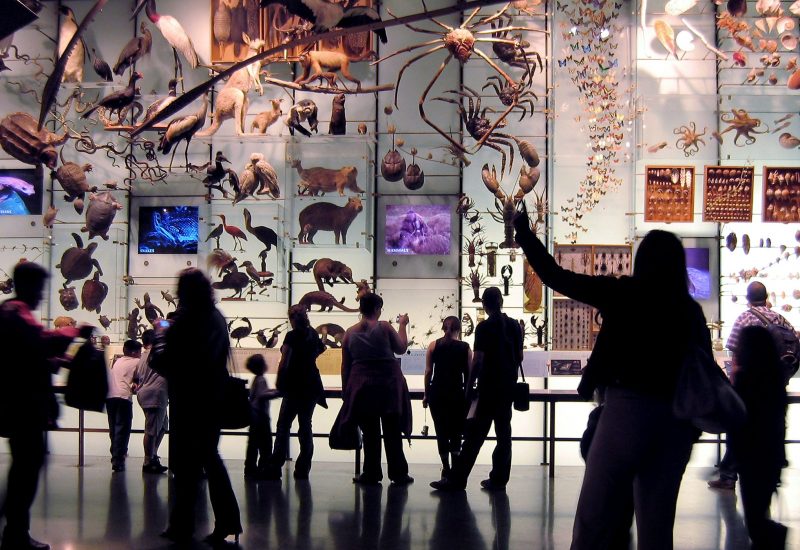
BLOG

(Photo: Robert R. Stone)
Learning Together at the Edge of the Future
If ever we need to be reminded of the interconnection between public knowledge, civil society and science, we can look back some 200 years to the works of the Prussian philosopher, linguist and educational leader Wilhelm von Humboldt. Humboldt argued that education must be considered in the context of society, and that civic education is paramount to broader understanding. He wrote, “People obviously cannot be good craftworkers, merchants, soldiers or businessmen unless, regardless of their occupation, they are good, upstanding and—according to their condition—well-informed human beings and citizens.”
Nearly two centuries later, we continue to grapple with questions of how to advance civic education, engagement and knowledge in an age of seemingly limitless access to information that too often lacks context, evidence or at times even validity.
Fortunately, many in the philanthropic sector are seeing even brighter lines connecting science, evidence, civic literacy and civic life. Much as Humboldt described, we are deeply aware of the need for “well-informed human beings and citizens,” and the mutually reinforcing nature of our work across domains, including science and civics.
In some sense, the intersection between science and society is at the heart of strategic philanthropy. In a chapter on the role of foundations in the Oxford Handbook of the Science of Science Communication (Oxford University Press, 2017), we look at philanthropic contributions to fostering public understanding of science, and developing and applying scientific evidence to inform more effective public decision-making. As just one example, between 1991 and 2009, the Robert Wood Johnson Foundation invested nearly $700 million to fight tobacco addiction in the United States. Smoking rates fell sharply during that time—and while there were many contributing factors, independent researchers later found that the Foundation’s collaborative coordination of policy research, advocacy and communications were credited by others as a key factor in shifting the balance away from tobacco, despite disinformation campaigns well-funded by the tobacco industry.
Now, as we face rapid advances in science and technology affecting every area of our lives, along with changing media and political landscapes—and significant disinformation efforts for our own time—we have even greater opportunity to work together to accelerate our effectiveness on behalf of scientific discovery and human progress. It speaks to the power of this moment that new, high-energy collaborative work is taking shape across a number of approaches, with many developments expected in the year ahead.
Convening stakeholders and mobilizing resources across disciplines
Talks are now available online from the recent Arthur M. Sackler Colloquium on the Science of Science Communication III, organized by the National Academy of Sciences to build connections between research, practice and philanthropy related to effective science communication. The colloquium, which carried forward recommendations from the consensus report Communicating Science Effectively: A Research Agenda, included an in-person audience of more than 500 and a webcast with 16,000 global views from Canada to Chile, and the Netherlands to New Zealand. Given the unusual mix of researchers, practitioners and funders, many lively conversations took place in the hallways between sessions and on Twitter (#SacklerSciComm). Key themes included the need for more collaboration between researchers and practitioners, and the need to understand and build engagement with diverse audiences.
A number of funders are eager to contribute to realizing these goals. At a breakfast meeting for funders we organized as part of the colloquium, the enthusiasm for increased partnership and shared learning across sectors moving forward was palatable. We look forward to advancing vital conversations, explorations and work together with this growing community.
New partnerships are already seeding change. For example, we have joined with the Kavli, Moore and Packard Foundations to understand and strengthen the systems involved in advancing scientists’ efforts to engage in the public sphere about their work and discoveries. The Science Philanthropy Alliance continues to be a vibrant forum for discussion about philanthropic support for the ecosystem of basic science research—including championing its role in society. Media Impact Funders will center discussions on communicating about science and evidence at the upcoming 2018 Media Impact Forum in Philadelphia. And at a time of heightened concern about the health of U.S. democracy, PACE (Philanthropy for Active Civic Engagement) is connecting with a broader group of funders, many working outside traditional “civic” spaces, to help the sector more effectively support informed and productive civic dialogue across differences.
We anticipate—and welcome—more exchanges of knowledge and pooling of efforts and resources across disciplines in the coming year.
Strengthening dialogue, feedback loops and experimentation
An exciting outcome of the recent Sackler Colloquium was the creation of new Building Capacity for Science Communication Partnership Awards, an open call to spark new collaborations between science communication researchers and practitioners. The two projects funded by the partnership awards are “Evaluating New Approaches to Promoting Vaccination,” involving researchers from Dartmouth College and practitioners from the Vermont Department of Health, led by Dartmouth’s Brendan Nyhan, and “Evidence-Based Science Communication to Policymakers,” involving a team from American University, the American Association for the Advancement of Science (AAAS) and Durham University led by American’s Elizabeth Suhay. AAAS is among the organizations running promising experiments in this arena—including SciLine, a new resource to support high-quality media coverage of science.
With the vast potential it holds for our time, cross-sector experimentation is ripe for additional philanthropic support. Philanthropy can make a key contribution by incentivizing and enabling new experiments designed by diverse teams. Our next opportunity for cross-sector teams will be a call for ideas leading up to a solutions forum that will address peer-to-peer sharing of misinformation, coordinated by Brian Southwell of RTI International, Duke University and the University of North Carolina at Chapel Hill, and coeditor of the new book Misinformation and Mass Audiences. (Watch our website for information about how to apply in the coming weeks.) With new technology, advances in behavioral science and an evolving world of social media, we are excited to see and share the ideas that emerge.
And, as we begin a new year, we affirm again, embedded in our efforts, a commitment to the exchange of ideas bolstering civil society and science, to bring about a future that reflects our highest potential.